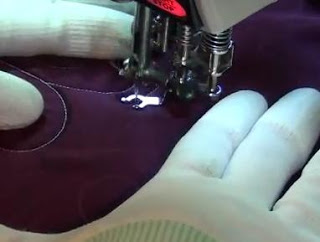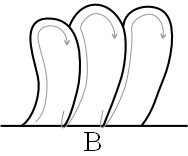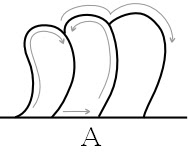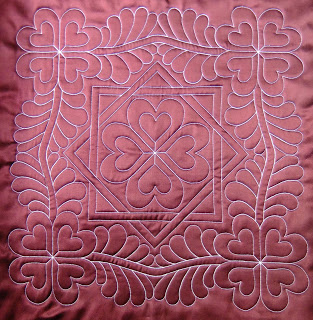Quilt Along #11: Outline Quilting
Last week we started working together to create this small Heart and Feather Wholecloth quilt:
 Just in case you’re running a bit behind, you can find this pattern here and last week’s post about it here.
Just in case you’re running a bit behind, you can find this pattern here and last week’s post about it here.
Today you should have your quilt top marked, basted and ready to go so let’s learn how to tackle outline quilting in free motion:
In this video I used a Queen Supreme Slider, Machingers, Bobbin Washers, and Isacord Thread when quilting this project. Of all of these tools, the gloves and thread were definitely the most helpful for maintaining control over the quilt and being able to quilt over the same area multiple times without breaking thread.
Now let’s talk through outline quilting on your Heart and Feather Wholecloth.
We can break this quilt down into 4 sections: center heart motif, middle interlocking squares, corner heart motifs, and the feathers.
For each section of the quilt, it’s a very good idea to spend some time tracing the paper pattern to get a mental idea of how you will quilt around each motif.
This allows you to plan ahead and minimize the amount of travel stitching you’ll need to do. It will also mentally prepare you for moving the quilt under your needle. Even though they’re marked lines, it’s still possible to get “lost” as you quilt each motif and not know where to stitch next.
Now let’s talk about some tips for staying on a line as you quilt. The biggest tip here is to GO SLOWLY. I had to speed up the video just to show you everything within 15 minutes, but I promise the machine was moving slower than usual in order to stay on the lines perfectly.
Also look at the position of your hands. Bring them slightly closer to your needle and spread your fingers wide for more control. Watch out for stitching through your fingers of course!
When quilting the straight lines, use your index finger as a guide by keeping it parallel with your needle and pushing the quilt straight through your machine. This will help keep those straight lines perfectly straight and right on the line without wiggles.
 It also helps to take breaks often, breathe, and shake your whole body to release tension. It’s very easy to get all wound up when stitching on a line and this tension will work against you.
It also helps to take breaks often, breathe, and shake your whole body to release tension. It’s very easy to get all wound up when stitching on a line and this tension will work against you.
Of course, this section of the quilt feels a lot like week 4, but this time we’re adding a new challenge: travel stitching.
Travel stitching or traveling is a necessary step to stitching this outline. In order to complete even the simplest section, the heart motifs, you HAVE to be able to quilt right on top of previous lines of quilting.
Beyond creating this wholecloth, traveling is a fundamental technique to free motion quilting. There are so many designs that require this skill so it will definitely pay off to spend some time working at it.
Personally I learned how to travel stitch by doing exactly what we’re doing this week: I marked designs and forced myself to stitch around them. Again and again I’d mark designs from Karen McTavish’s book Secrets of Elemental Quilting onto white fabric then quilt on the lines, travel stitching whenever I needed to.
It wasn’t perfect and it took several motifs before the skill started to emerge. Even now I still make mistakes and stitch off the line if I’m not focused on what I’m doing. It happens! Don’t beat yourself up about it and don’t rip it out unless you absolutely can’t stand it.
Of course, travel stitching can be extremely annoying if you’re constantly breaking thread every time you try it. Sometimes you’ll need to be able to travel stitch 2 to 5 times over the same area and most cotton threads are simply too weak and too thick for this job.
I’m using Isacord thread in this video because it’s very thin and very strong and able to stitch over itself without breaking. If you’re absolutely insistent on using cotton, Aurifil’s 50 wt mako cotton will probably be your best bet.
Now the last section of the video covered feathers, one of the most beautiful elements to stitch on a quilt, but also one that gives many beginners fits.
So we learned two different ways of quilting around these feathers. Of course, there are many more ways to quilt around feathers and even more ways to quilt them freeform, but let’s learn these two methods today:
Travel Back Feather – This feather is formed by hitting the vine line, then traveling along the back of the previous feather then swinging out to form the next. All the travel stitching will run between the feathers, making them stand out nicely on your quilt.

Bump Bump Feather – This feather is formed by traveling along the vine, forming a feather, then traveling back along the top of that feather and bumping off to swing out with the next feather.

Give both of these methods a try and see which one works best for you! Also play with the direction and angle you stitch the feathers in. Feathers are challenging only because they angle and bend in a fluid way that is hard to stitch unless it feels natural for you.
The best advice I have is to PLAY. Don’t obsess about perfection, just stitch on the lines and accept whatever happens. You may even want to mark several tops to play with simply so you don’t get too worked up about small mistakes.
 Now it’s time to link up your progress from last week preparing your wholecloth quilt!
Now it’s time to link up your progress from last week preparing your wholecloth quilt!
Instructions for Linking Up Your Blog:
1. Write your blog post. Publish it on your blog.
2. Copy the link of the specific blog post. This is not just the link to your blog itself (www.freemotionquilting.blogspot.com), but the link to the specific post: https://freemotionproject.com/2012/01/quilt-along-2-quilting-in-rows.html
3. Click the blue link up button above and paste your link into the box.
Keep in mind that you’re posting your progress from LAST week on THIS week’s post. This way you have time to watch the lesson, play with the ideas, then post your progress to the next quilt along. I hope that makes sense!
As always, any questions you have, please post them in the comments below or on your blog and I’ll answer 5 tomorrow on Question Thursday.
Time for me to shut up and quilt,
Leah Day

I know you said don't be afraid, but I get really scared stitching back over another line of stitching. I guess I shouldn't worry about, especially since it's only practice. I did not prepare the wholecloth last week, but I'm thinking I might practice following designs/lines and do some backtracking over stitches. It will be good practice. Oh, and I like the shiny fabric 🙂
Here come the negative thoughts. Embarassingly bad. Really bad. I CANNOT travel stitch without overlapping. It's awful. Do I just leave it? My stitches are so small it would probably be impossible to pick them out. Garbage. Maybe this is not for me! It's so hard. Ok. I'm done whining. Good luck, everyone! You sure make it look easy, Leah!
That index finger tip is great! It's funny to think of the human body as having straight lines that can help a person out, since we're normally so bumpy and/or curvy, but in this case it's totally true!
pierro's mum, rosemary here: Your video instruction is always so inspiring! I am working working hard at this. It does not look beautiful but I am proud of actually learning and trying.
@a1angiem: just keep trying. When you finish a project, give it away to a lovely friend, and then you do not have to look at it anymore haha
Hi Leah, I had tried travel stitching on my last quilt for feather petals and didn't really like the effect. And went back to the way Feburary's SewCalGals's FMQ Challenge tutorial by Diane.
So, I'm little nervous about travel stitching.
The other question I had is, I'm going to be using a pale pink fabric, so what color thread should I be using. I know there are going to many options. But at least some direction would be great. If I had choose a dark color fabric I would have easily used a white color thread to pop. So, for light color fabric what should we keep in mind while choosing the thread color for this project?
cheers,
Malini
hi Leah, on this quilt is it better to match the fabric or opt for a lighter colour to give different effect? I noticed yours was done in a lighter colour, but my first thought was to match it to cloth.
i re-linked up because Pat let me know She couldn't view it. Thanks Pat! I changed the name of my blog last night, right around the time I linked up. i guess I confused things a bit?? I should have known something was wrong when none of my pics from my blog showed up. Also, I'm a fairly new blogger. Just when I get used to things, google goes and changes it. Does anyone else have this issue:When I go to my dashbord to view new posts, I can't click on them anymore.I have to use google reader. Quite annoying. Sorry no quilt comment, Leah, except to say It's really fun to be part of a quilting group! And Thanks for being our teacher:)
I'm late! I pre-washed, starched, traced, and outlined today!
I noticed in this post that I made this harder on myself- I started each inner heart on it's own, because there were no lines connecting them. Here I see you connected them to the outer hearts.
Thanks for drawing such a fun design for us! Can't wait for the next step.
Leah…
When I travel, I find that my needle flags and I can sometimes see the top thread on the bottom. I changed the needle and the tension but I still seemed to have that problem. Is it operator error or the nature of the beast when travelling?
So I jumped in on this project, never having done any of your previous free motion lessons at all. It's pretty shaky, but I'm having fun. Thanks Leah.
See a photo of my project with the outline stitching here
http://wisconsinquilting.wordpress.com
Out of all the free motion quilting lessons I've seen yours have been the best , I've been able to follow along and to get the hang of it a lot easier and today I'm going out to invest in some quilting gloves. Thank you so much for the designs I love them they are gorgeous and a lot of fun. I look forward to doing some more.